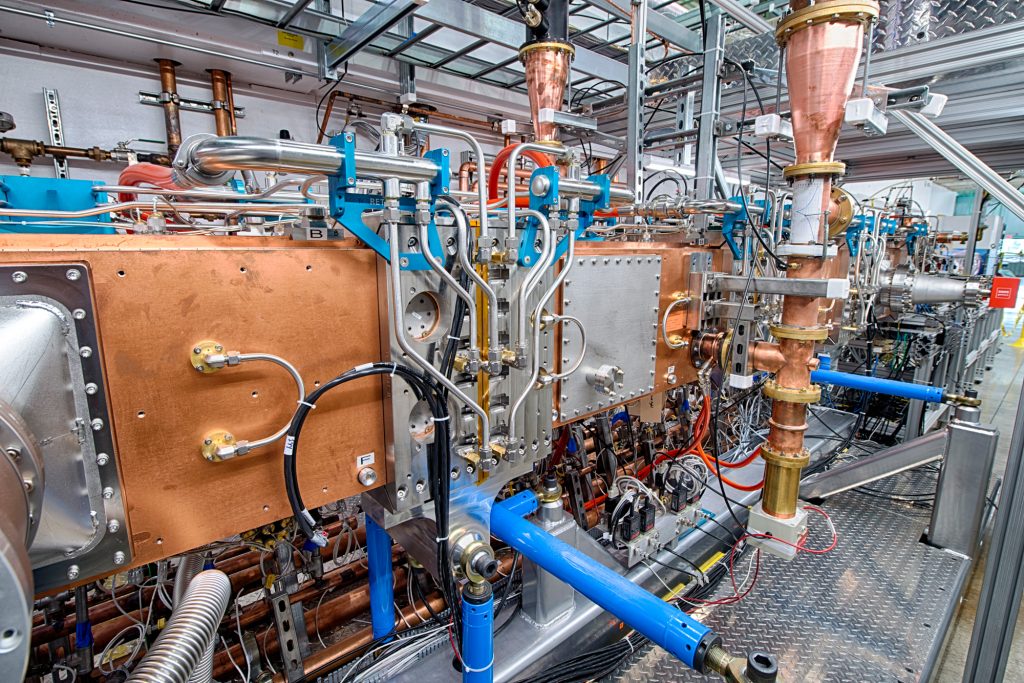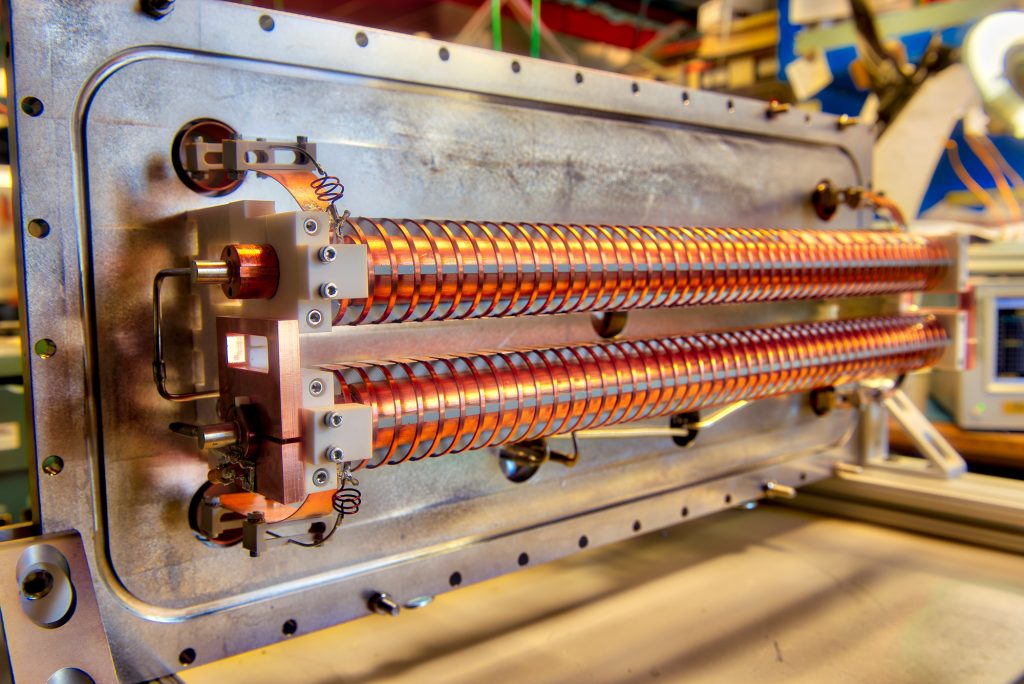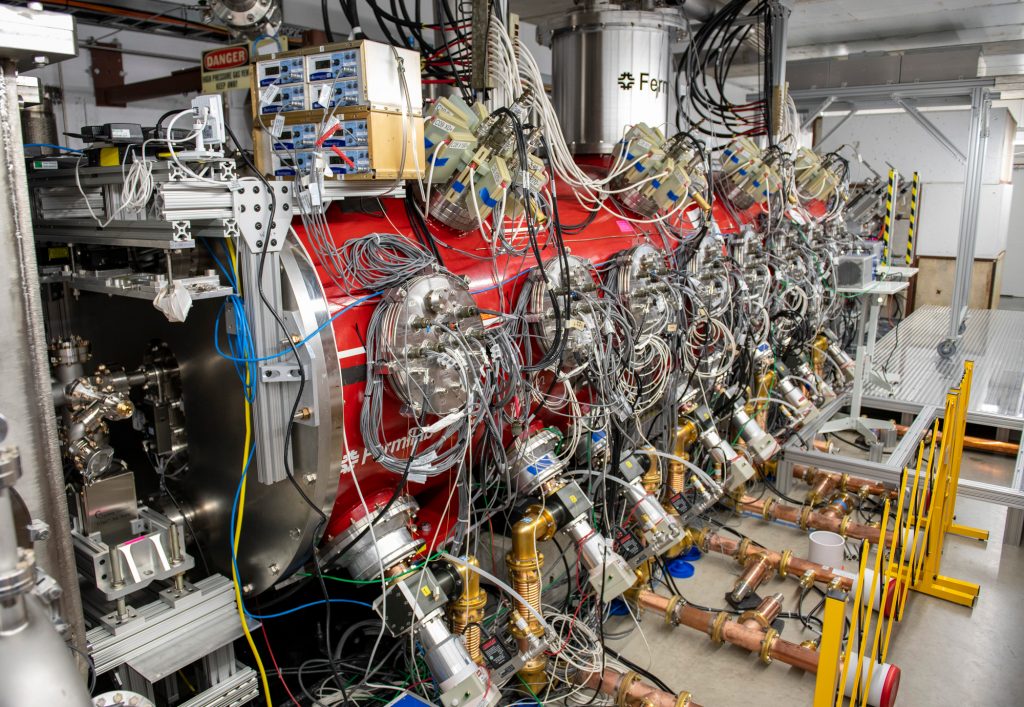The proof-of-concept for a world-record beam
The PIP-II Injector Test facility, also known as PIP2IT, has been constructed as a testbed for the novel technologies PIP-II will rely on. PIP2IT replicates the first 25-million-electronvolts, or 25 MeV, of the PIP-II linear accelerator, or linac. PIP2IT validated design choices and demonstrated that these technologies will meet PIP-II performance goals in an operational setting. Following these demonstrations, PIP2IT will be disassembled, moved and reinstalled in the PIP-II facility as that linac’s upstream end.
Construction on PIP2IT, which lasted from 2016 to 2020, is complete.
The ion source, where hydrogen gas transforms to H-minus ions, and the radio frequency quadrupole, which provides beam acceleration at room temperature, comprise the upstream end of PIP2IT (and of PIP-II). They produce an H-minus ion beam that emerges from the RFQ with an energy of 2.1-million-electronvolts, or 2.1 MeV, with characteristics suitable for acceleration in the superconducting portion of the linac.
What follows is a detailed explanation of PIP2IT’s components, which will become the PIP-II’s upstream end.

Bunch structure helps the beam ‘surf the wave’
In addition to accelerating the H-minus beam, the RFQ imposes a bunch structure; the H-minus beam exits the RFQ in discrete groups, or bunches. Each bunch is separated from the next by about 6 nanoseconds, or billionths of a second, and is about one nanosecond in duration.
Without this bunch structure most of the beam would arrive at the entrance to the linac at a time that would not let it draw energy from the electromagnetic waves in the cavities, or surf the wave. To synchronize the ions with the waves, precision — better than a nanosecond — is key. Indeed, bunch structure is needed to accelerate the H-minus beam in the superconducting linac.
Stripping and chopping extra bunches to refine the beam
Not all the bunches delivered from the RFQ are required for the Deep Underground Neutrino Experiment at the Long-Baseline Neutrino Facility. Immediately downstream from the RFQ, a medium energy beam transport, or MEBT, removes these “extra” bunches, further conditioning the H-minus ion beam for injection into the linac. The MEBT is roughly 14 meters long.
In the MEBT, a chopper applies a sideways electric field to kick the excess bunches out of the beam. The chopper is extremely demanding from a technical perspective, as it applies about 1,000 volts to the beam, while having the capability to turn on or off in a few nanoseconds. The chopper design in PIP-II is unique in that it allows the pattern of turning on and turning off to be modified to create any desired pattern.
PIP2IT has already demonstrated that the ion source, RFQ, MEBT and chopper will meet PIP-II performance requirements.


Experiments probe cryomodule performance
After the beam has been conditioned in the MEBT, it runs through one cryomodule, then another; on the way to 800 MeV, the beam will run through 23. Cryomodules are vessels that house and insulate superconducting radio-frequency cavities at ultracold temperatures. The first two in PIP-II’s linac are installed and operational at PIP2IT. Initial experiments aim to understand the cryomodules’ sensitivity to beam characteristics coming from the MEBT, as well as understand and optimize their performance.
The components installed in PIP2IT come from around the world thanks to Fermilab’s international partnerships.
PIP2IT demonstrates primary technology goals PIP-II will rely on
PIP2IT established the following:
- The ion source, where hydrogen gas transforms to H-minus ions, will meet PIP-II performance goals for the H-minus beam current and beam density
- The radio-frequency quadrupole, which provides beam acceleration at room temperature, will meet PIP-II performance goals for the H-minus injection into the superconducting linac
- The ability to tailor bunch distributions to meet PIP-II requirements
- Efficient beam acceleration through the first two superconducting cryomodule types, which house cavities in the half-wave-resonator and single-spoke-resonator families, respectively
